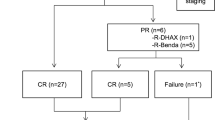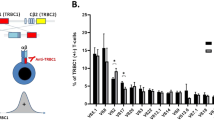Abstract
The aim of this study was to evaluate whether a quantitative analysis of circulating t(14;18)-positive cells is of prognostic significance in patients with follicular lymphoma (FL) after myelo-ablative therapy supported by ABMT. We tested DNA from primary lymphoma tissue as well as PBMC before and after ABMT from 15 patients for the presence of the t(14;18) translocation. Nine patients showed a t(14;18) translocation, six patients were t(14;18)-negative. Circulating t(14;18)-positive cells of seven patients were quantitatively determined by limiting dilution assays combined with a two-step PCR and by real-time quantitative PCR. The results of both methods correlate very well. The number of circulating t(14;18)-positive cells decreased significantly in all patients after myeloablative therapy and ABMT, t(14;18)-negative blood samples were found in five of seven patients. In all patients circulating t(14;18)-positive cells reappeared within 2 years after ABMT showing two different patterns. During continuous CR the numbers of circulating t(14;18)-positive cells were found to be stable within one order of magnitude. In contrast, in one patient the relapse was accompanied by a logarithmic increase of t(14;18)-positive cells. In a second patient the enlargement of lymph nodes developing over a period of 12 months was accompanied by very slowly increasing numbers of t(14;18)-positive cells. In all cases where diagnostic lymph node tissue was available, the same t(14;18) translocation was found at first diagnosis and after ABMT as shown by nucleotide sequence analysis. We conclude that the quantitative detection of circulating t(14;18)-positive cells during follow-up of patients with FL after ABMT reflects the clinical course of the disease. Relapses are associated with increasing numbers of circulating t(14;18)-positive cells and continuous complete remissions with stable cell counts. Bone Marrow Transplantation (2000) 25, 419–426.
This is a preview of subscription content, access via your institution
Access options
Subscribe to this journal
Receive 12 print issues and online access
$259.00 per year
only $21.58 per issue
Buy this article
- Purchase on Springer Link
- Instant access to full article PDF
Prices may be subject to local taxes which are calculated during checkout



Similar content being viewed by others
References
Gallagher CJ, Gregory WM, Jones AE et al. Follicular lymphoma: prognostic factors for response and survival J Clin Oncol 1986 4: 1470–1480
Romaguera JE, McLaughlin P, North L et al. Multivariate analysis of prognostic factors in stage IV follicular low-grade lymphoma: a risk model J Clin Oncol 1991 9: 762–769
MacManus MP, Hoppe RT . Is radiotherapy curative for stage I and II low-grade follicular lymphoma? Results of a long-term follow-up study of patients treated at Stanford University J Clin Oncol 1996 14: 1282–1290
Horning SJ, Rosenberg SA . The natural history of initially untreated low-grade non-Hodgkin's lymphomas New Engl J Med 1984 311: 1471–1475
Hubbard SM, Chabner BA, DeVita VTJ et al. Histologic progression in non-Hodgkin's lymphoma Blood 1982 59: 258–264
Yuen AR, Kamel OW, Halpern J, Horning SJ . Long-term survival after histologic transformation of low-grade follicular lymphoma J Clin Oncol 1995 13: 1726–1733
Weisdorf DJ, Andersen JW, Glick JH et al. Survival after relapse of low-grade non-Hodgkin's lymphoma: implications for marrow transplantation J Clin Oncol 1992 10: 942–947
Armitage JO . Drug therapy: treatment of non-Hodgkin's lymphoma New Engl J Med 1993 328: 1023–1030
Rohatiner AZS, Johnson PWM, Price CGA et al. Myeloablative therapy with autologous bone marrow transplantation as consolidation therapy for recurrent follicular lymphoma J Clin Oncol 1994 12: 1177–1184
Haas R, Moos M, Mohle R et al. High-dose therapy with peripheral blood progenitor cell transplantation in low grade non-Hodgkin's lymphoma Bone Marrow Transplant 1996 17: 149–155
Freedman AS, Gribben JG, Neuberg D et al. High-dose therapy and autologous bone marrow transplantation in patients with follicular lymphoma during first remission Blood 1997 88: 2780–2786
Bierman PJ, Vose JM, Anderson JR et al. High-dose therapy with autologous hematopoietic rescue for follicular low-grade non-Hodgkin's lymphoma J Clin Oncol 1997 15: 445–450
Gribben JG, Neuberg D, Freedman AS et al. Detection by polymerase chain reaction of residual cells with the bcl-2 translocation is associated with increased risk of relapse after autologous bone marrow transplantation for B-cell lymphoma Blood 1993 81: 3449–3457
Johnson PWM, Price CGA, Smith T et al. Detection of cells bearing the t(14;18) translocation following myeloablative treatment and autologous bone marrow transplantation for follicular lymphoma J Clin Oncol 1994 12: 798–805
Williams CD, Goldstone AH, Pearce RM et al. Purging of bone marrow in autologous bone marrow transplantation for non-Hodgkin's lymphoma: a case-matched comparison with unpurged cases by the European Blood and Marrow Transplant Lymphoma Registry J Clin Oncol 1996 14: 2454–2464
Yunis JJ, Oken MM, Kaplan ME et al. Distinctive chromosomal abnormalities in histologic subtypes of non-Hodgkin's lymphoma New Engl J Med 1982 307: 1231–1236
Bloomfield CD, Arthur DC, Frizzera G et al. Nonrandom chromosome abnormalities in lymphoma Cancer Res 1983 43: 2975–2984
Tsujimoto Y, Croce CM . Analysis of the structure, transcripts, and protein products of bcl-2, the gene involved in human follicular lymphoma Proc Natl Acad Sci USA 1986 83: 5214–5218
Cleary ML, Galili N, Sklar J . Detection of a second t(14;18) breakpoint cluster region in human follicular lymphomas J Exp Med 1986 164: 315–320
Tsujimoto Y, Bashir MM, Givol I et al. DNA rearrangements in human follicular lymphoma can involve the 5′ or the 3′ region of the bcl-2 gene Proc Natl Acad Sci USA 1987 84: 1329–1331
Bakhshi A, Jensen JP, Goldman P et al. Cloning the chromosomal breakpoint of t(14;18) human lymphomas: clustering around Jh on chromosome 14 and near a transcriptional unit on 18 Cell 1985 41: 899–906
Stetler-Stevenson M, Raffeld M, Cohen P, Cossman J . Detection of occult follicular lymphoma by specific DNA amplification Blood 1988 72: 1822–1825
Negrin RS, Kiem HP, Schmidt IGH et al. Use of the polymerase chain reaction to monitor the effectiveness of ex vivo tumor cell purging Blood 1991 77: 654–660
Finke J, Slanina J, Lange W, Dölken G . Persistence of circulating t(14;18)-positive cells in long-term remission after radiation therapy for localized-stage follicular lymphoma J Clin Oncol 1993 11: 1668–1673
Gribben JG, Freedman AS, Neuberg D et al. Immunologic purging of marrow assessed by PCR before autologous bone marrow transplantation for B-cell lymphoma New Engl J Med 1991 325: 1525–1533
Price CGA, Meerabux J, Murtagh S et al. The significance of circulating cells carrying t(14;18) in long remission from follicular lymphoma J Clin Oncol 1991 9: 1527–1532
Limpens, J, De Jong D, Van Krieken JHJM et al. Bcl-2/JH rearrangements in benign lymphoid tissues with follicular hyperplasia Oncogene 1991 6: 2271–2276
Aster JC, Kobayashi Y, Shiota M et al. Detection of the t(14;18) at similar frequencies in hyperplastic lymphoid tissues from American and Japanese patients Am J Pathol 1992 141: 291–299
Limpens J, Stad R, Vos et al. Lymphoma-associated translocation t(14;18) in blood B cells of normal individuals Blood 1995 85: 2528–2536
Dölken G, Illerhaus G, Hirt C, Mertelsmann R . BCL-2/JH-rearrangements in circulating B cells of healthy blood donors and patients with nonmalignant diseases J Clin Oncol 1996 14: 1333–1344
Liu Y, Hernandez AM, Shibata D, Cortopassi GA . BCL2 translocation frequency rises with age in humans Proc Natl Acad Sci USA 1994 91: 8910–8914
Ji W, Qu G, Ye P et al. Frequent detection of bcl-2/JH translocations in human blood and organ samples by a quantitative polymerase chain reaction assay Cancer Res 1995 55: 2876–2882
Stiff PJ, Koester AR, Weidner MK, Fisher RI . Autologous bone marrow transplantation using unfractionated cells cryopreserved in dimethylsulfoxide and hydroxylethyl starch without controlled-rate freezing Blood 1987 70: 974–978
Stansfeld AG, Diebold J, Noel H et al. Updated Kiel classification for lymphomas Lancet 1988 1: 292–293
Dyer MJS, Fischer P, Nacheva E et al. A new human B-cell non-Hodgkin's lymphoma cell line (Karpas 422) exhibiting both t(14;18) and t(4;11) chromosomal translocations Blood 1990 75: 709–714
Dubeau L, Chandler LA, Gralow JR et al. Southern blot analysis of DNA extracted from formalin-fixed pathology specimens Cancer Res 1986 46: 2964–2969
Goelz SE, Hamilton SR, Vogelstein B . Purification of DNA from formaldehyde-fixed and paraffin-embedded human tissue Biochem Biophys Res Commun 1985 130: 118–126
Heid CA, Stevens J, Livak KJ, Williams PM . Real time quantitative PCR Genome Res 1996 6: 986–994
Dölken L, Schüler F, Dölken G . Quantitative detection of t(14;18)-positive cells by real time quantitative PCR using fluorogenic probes Bio Techniques 1998 25: 1058–1064
Cleary ML, Sklar J . Nucleotide sequence of a t(14;18) chromosomal breakpoint in follicular lymphoma and demonstration of a breakpoint-cluster region near a transcriptionally active locus on chromosome 18 Proc Natl Acad Sci USA 1985 82: 7439–7443
Ravetch JV, Siebenlist U, Korsmeyer S et al. Structure of the human immunoglobulin μ locus: characterization of embryonic and rearranged J and D genes Cell 1981 27: 583–591
Hirt C, Dölken L, Dölken G . Quantitative determination of t(14;18)-positive cells in long term remission after radiotherapy for low stage follicular lymphoma (submitted for publication)
Acknowledgements
This paper is dedicated to Karl G Blume on the occasion of his 60th birthday. We gratefully acknowledge the excellent technical assistance of Marika Held and Jens Fischer. We are grateful to E Kohlund and AI Soerjanta for their help in collecting blood samples and reviewing clinical data, and to G Illerhaus and D Layer for their help in sequencing all t(14;18)-translocations ever found in our laboratory. We also thank Prof Dr HE Schaefer and Dr G Köhler (Pathol Inst, University Freiburg, Germany), Prof Dr R Parwaresch (Hämatopathol Inst, University Kiel, Germany), Prof Dr B Helpap (Path Inst, Singen, Germany) and Prof Dr H Frenzel (Path Inst, Karlsruhe, Germany) for providing formalin-fixed, paraffin-embedded tissue blocks or tissue sections for PCR analysis. They also provided histologic confirmation that the tissue block or tissue sections being used for PCR analyses contain the initially diagnosed lymphoma.
Author information
Authors and Affiliations
Rights and permissions
About this article
Cite this article
Hirt, C., Dölken, G. Quantitative detection of t(14;18)-positive cells in patients with follicular lymphoma before and after autologous bone marrow transplantation. Bone Marrow Transplant 25, 419–426 (2000). https://doi.org/10.1038/sj.bmt.1702147
Received:
Accepted:
Published:
Issue Date:
DOI: https://doi.org/10.1038/sj.bmt.1702147
Keywords
This article is cited by
-
The implication of follicular lymphoma patients receiving allogeneic stem cell transplantation from donors carrying t(14;18)-positive cells
Bone Marrow Transplantation (2005)
-
Reduced-intensity rituximab-BEAM-CAMPATH allogeneic haematopoietic stem cell transplantation for follicular lymphoma is feasible and induces durable molecular remissions
Bone Marrow Transplantation (2003)
-
Concurrent presence of both patient and donor t(14;18) in a follicular lymphoma patient after undergoing allogeneic BMT: implications for minimal residual disease detection post-transplant
Bone Marrow Transplantation (2003)
-
Detection of minimal residual disease in hematologic malignancies by real-time quantitative PCR: principles, approaches, and laboratory aspects
Leukemia (2003)
-
Quantitative molecular evaluation in autotransplant programs for follicular lymphoma: efficacy of in vivo purging by Rituximab
Bone Marrow Transplantation (2003)



